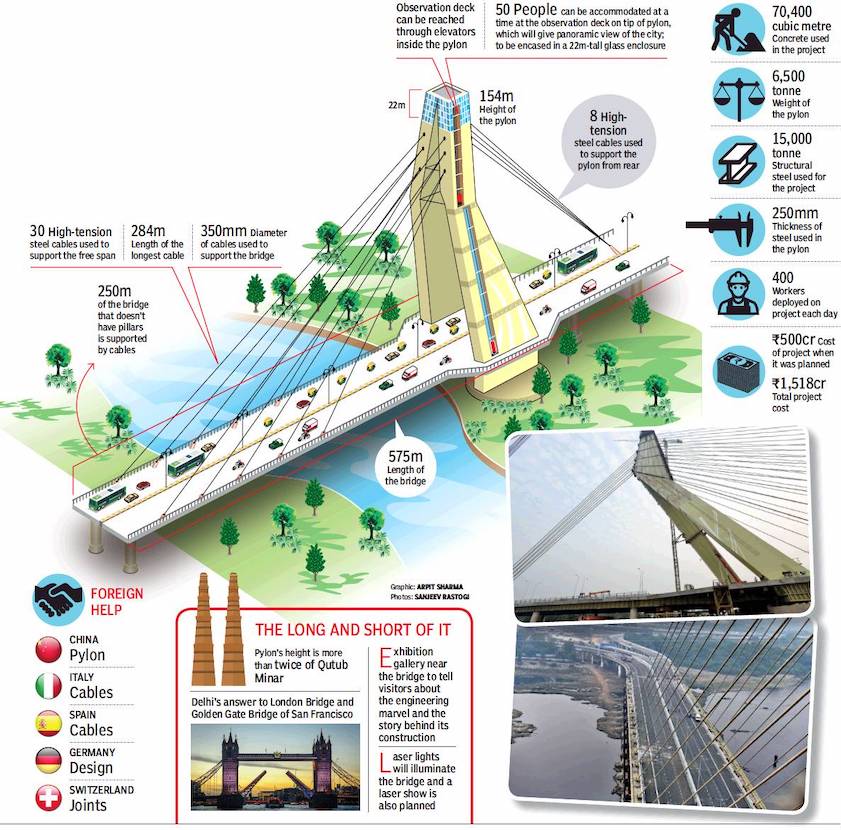Delhi: Signature Bridge
This is a collection of articles archived for the excellence of their content. |
Highlights, as when inaugurated/ 2018

From: Sidhartha Roy, Delhi’s tall order: 14-yr suspended animation ends in a namaste, November 3, 2018: The Times of India
Iconic Structure, Touted As New Symbol Of Capital, Will Give A Panoramic View Of City.
As you approach north Delhi’s Wazirabad on Outer Ring Road, there’s a thick haze obscuring the panorama. But you can still see the impressive structure of the Signature Bridge looming ahead. Fourteen years in the making, the much-delayed link between the two sides of the Yamuna will be inaugurated on Sunday, and people can start using it from the following day. Delhi government believes that its unique shape will forever be associated with the capital, as much as Qutub Minar or Lotus Temple, and become Delhi’s answer to London Bridge or San Francisco’s Golden Gate Bridge.
The pylon, shaped like a boomerang but more angular and among the tallest in Asia, distinguishes Signature Bridge from all others across the Yamuna. The cable-stayed structure, executed by the Delhi Tourism and Transportation Development Corporation (DTTDC), will reduce the distance between the areas on either side of the river from 45 minutes now to just 10 minutes.
“The pylon’s two legs rise in the shape of hands and meet in the middle in a ‘namaskar’. It is a way of greeting visitors,” a DTTDC official explained. The two inclined columns are rigidly connected to the driving lanes and bend midway. Its upper portion anchors the backstay cables and the main-span cables, arranged like in a harp. At the top is a 22-metre steel-glass structure that will permit a panoramic view of the city. Entry inside the pylon will be ticketed and facilitated through high-speed elevators. The first set of elevators, one each on the inclined legs will take visitors to the mid-section, from where they can take a vertical elevator to the top to get a bird’s-eye view of Delhi.
Apart from easing travel, the bridge is envisaged as a tourist attraction and the next phases will develop cafeterias, parking space and exhibition galleries. “Delhi hasn’t got a new iconic structure since the Lotus Temple in the 1980s and the state government felt the need for one,” said a DTTDC official. “The pylon design was conceptualised by a German firm and given shape by an Indian architect and was chosen from 15 shortlisted designs.”
Though DTTDC was awarded the project in 2004, actual construction of the approach roads began only in 2008 and of the bridge in 2010. Because the steel required by the design was not available in India, the pylon segments were fabricated in China and shipped to a port in Gujarat in 16 parts. It took two years for all the components to reach India.
Deck instead of iron mesh to protect river from waste
Unlike other bridges over the Yamuna, the newly opened Signature Bridge won’t have any iron mesh to prevent people from throwing waste, including religious items, into the river.
Engineers associated with the project said iron mesh would have spoilt the bridge’s aesthetics. However, there are other arrangements to prevent such a situation, one of them claimed. “We have built a maintenance deck along the bridge and anything thrown from the bridge is likely to land on it,” said Shishir Bansal, chief project manager of Delhi Tourism and Transportation Development Corporation (DTTDC), the agency executing the plan.
Bansal said the iconic bridge was the only such facility in the country for which the Delhi government had taken an environmental clearance. The question of iron mesh came up when the government had applied for the environment clearance.
“The appraisal committee of the Union environment ministry was convinced with the argument that iron mesh was not required. However, if it is ever observed that waste being thrown from the bridge is reaching the river and polluting it, mesh can be erected. We have made arrangements for that,” he added.
While the bridge was opened for traffic on Monday, the construction agency now has to complete the 22-metrehigh steel and glass observation deck on the top of the 154-metre pylon, which will offer a 360-degree panoramic view of the city.
The engineers of Gammon, one of the oldest construction companies carrying out the civil work, said the focus would now be on completing the installation of highspeed lifts, flooring of the four-storey observation deck, pylon maintenance unit and the glass facade. “All work will go on simultaneously to complete the missing links. We hope to complete all work by the end of January so that the observation deck could be opened for public in February,” said an engineer associated with the project.
Bansal said the bridge and its pylon were also being installed with a monitoring system to check if the structure was behaving according to its design.